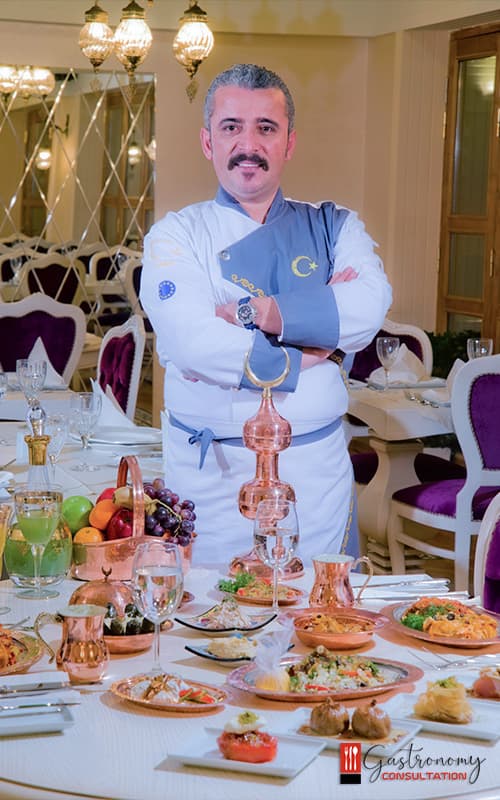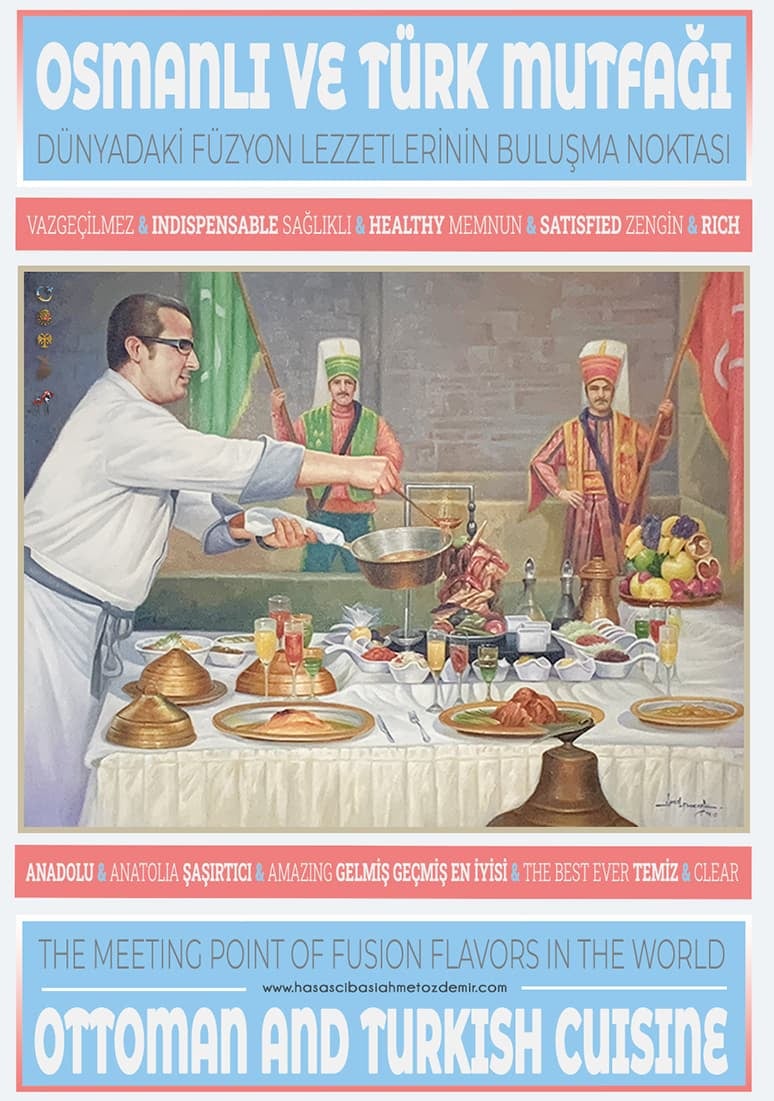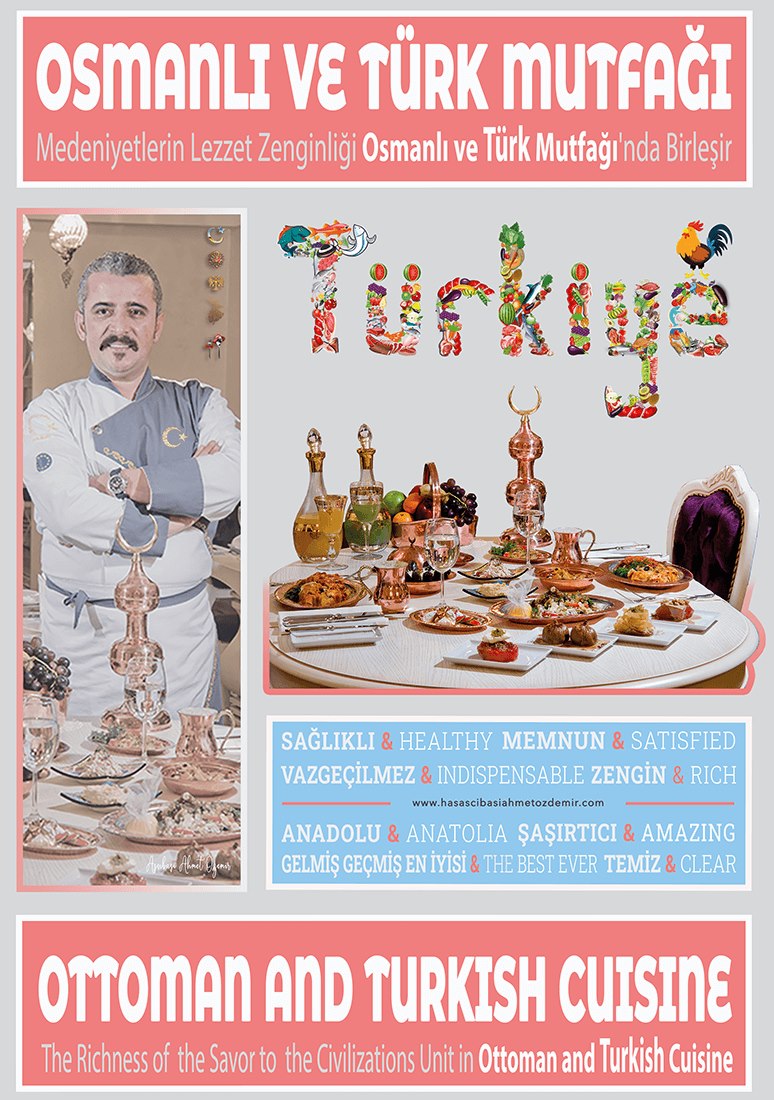The kitchen section of Topkapı Palace, which was built by Fatih Sultan Mehmed between 1475 and 1478, covers an area of 5250 square meters. Apart from the sections where the food is cooked, there are - cellars, - wards of cooks and apprentices, - a fountain, - a mosque - a hamam.

Ottoman Palace Cuisine...
Has Chef Ahmet Ozdemir
Starting Note:
I would like to state that I registered the same definition as "
Ottoman Palace Cuisine " on the " wikipedia " website on July 01, 2020, together with the content definitions .
Ottoman palace cuisine or matbah-ı âmire is the name given to the palace cuisine in the Ottoman Empire.
Contents:
1 - Palace Kitchen
2 - Kitchen services
3 - Supreme Matbah-i Has
4 - Head Chef
5 - Table services
6 - Halva Makers
7 - Other chapters
8 - Bibliography
Palace Cuisine
The kitchen section of Topkapı Palace, which was built by Fatih Sultan Mehmed between 1475 and 1478, covers an area of 5250 square meters. Apart from the sections where the food is cooked, there are - cellars, - wards of cooks and apprentices, - a fountain, - a mosque - a hamam.
In the kitchen, which consists of 8 sections, each section has a separate stove, a separate oven, and cooks and apprentices with different areas of expertise. In the 16th century , a group of 60 cooks, consisting of dough makers, bagel makers, pilaf makers, kebab makers, aviaries, vegetable makers, and dessert makers, and 200 appetizers worked in the
Turkish Culinary Culture palace kitchen . At their head was the Chief Chef as a high-ranking official.
Matbah-ı Amire housed many establishments such as a vegetable shop, cellar, butcher shop, along with kitchens. The palace kitchens consisted of 10 rooms, two of which belonged to the halvahhane. From the sultan to the lowest palace official, everyone's meals were cooked in these kitchens. All these kitchens were built on the right side of the second courtyard in the Birun part of the palace. The sultan alsobenefited from the special kitchen called Kuşhane , located in the Enderun section and served by master chefs.
Kitchen services
Meals prepared for the Divan Viziers and the people of the Harem in Topkapı Palace are in the Has Kitchen , special meals for the sultan are in the Kuşhane Kitchen , the senior women of the harem are in the Valide Sultan's Kitchen, the eunuchs are in the Kızlarağası Kitchen, the Door Aghas and Court officials are in a separate kitchen, the head of the Treasury and his entourage, the Kilercibaşı and his entourage, the palace lord and his entourage were cooking in separate kitchens.

Although the number of these services, which prepared meals for approximately 4000 people a day, and cooked soup, pilaf-zero for 10,000 Janissaries on special days, was about 500 in the 18th century, although it changed from time to time. In addition to these, about 400 Helvacı would prepare sweet foods (halva, paste, sherbet, etc.).
The masters of the palace cooks were called Üstündan-ı Matbah-ı Has . The journeymen subordinate to them, and later the head of the divisions and the shagirts were coming. To these, it is necessary to add around 300 cooks and the special chefs of the Kileraghas, Treasuredarbasi, Kilercibasi and Saray Aghas, who have close to 100 cooks. If necessary, a special menu was prepared for the upper echelons of the harem. All these servants were experts in their fields, known by the names of Chef , Chef, Grill, Kebab, Pastry, Rice, Fisherman and Dietitian.
Medicines needed by the physicians were made in the palace kitchen, which was also a pharmacy, and the meals cooked for the sultan ( the sultan 's meals ) were prepared in the aviary kitchen. The cooks who prepared the dishes to go to the Sultan consisted of the cook and halva maker selected from among the reliable people of Zülüflü Baltacılar , as well as the journeymen who were affiliated with them.
Meals that required special dexterity in their preparation were cooked in single pots, and if the Sultan went on a campaign, the aviary kitchen staff would go with him.
Ustadan-i Matbah-i Has
It is the name given to the most knowledgeable and most authoritative of the experienced cooks in the kitchen sections of the palace kitchen in the rich Ottoman Cuisine history .
Although "has" in Ottoman means the best, it mostly means "person" or "area" belonging to the sultan, in the service of the sultan. For example, it is used for the things that belong to the sultan, such as a private garden, a private income, a special kitchen, a special room. When we consider pure gold and pure silver, it is used to mean the essence and most valuable of an object. The word Matbah (Matbah-ı Âmire) means the place where food is cooked, that is, the kitchen.
From this point of view, the meaning of the term "Üstüdan-ı Matbah-ı Has" is used as " the best of the masters in the Ottoman kitchen organization ", the most knowledgeable, the person who has knowledge and experience in all kitchen departments and kitchen services.
Chef
Chef in the Ottoman palace kitchen; He is the person who is competent and knowledgeable in the kitchen he belongs to. Among the kitchen departments in the Ottoman palace kitchen organization (Has Kitchen, Kuşhane Kitchen, Valide Sultan Kitchen, Kizlaragasi Cuisine), each kitchen has a chef. Among the employees of these kitchen departments; Chefs such as cooks, hearth cooks, kebab cooks, desserts, pastries, halva makers, rice cooks, fishermen, and fast food cooks who prepare the meals prescribed by physicians work.
Ottoman Palace Cuisine

In the Ottoman palace kitchen , which is also a school (hearth) and has a " left system ", there are journeymen, division heads and şagirts (assistant apprentices) who serve all these cooks. The person (chef of the cooks) who assigns the employees in other departments in the Ottoman palace kitchen, controls the operation of the work and personally inspects the quality of the meals made before the meals go to table service is called the "chief cook".
In the Ottoman Palace kitchen organization, Üstündan-ı Matbah-ı Has is responsible to the matbah-ı chief and, when necessary, to the Kilercibaşı. Today, in professional kitchens, the duties of the chef are more detailed and different.
table services
In the harem, a woman from a senior harem, called a çeşnigir master, handled the table services. Peşkircibaşı was chosen from among the senior cellarists. The person who kept the peşkirs was the Peşkir Gulam. Sultan II. Only the Kilercibaşı would serve Abdulhamid at the table. Those closest to the sultan were the people of Hasoda. The Sultan used to eat alone in the Has Room or in the terraces and gardens, use his spoon and fingers to eat, and then wash his hands with soap. Ibrik Gulam and Ibriktar were assigned to wash the sultan's hands before and after the meal. All these tasks were performed by the Enderun aghas. The duties that each of them would be promoted to were clear.
Helvacilar - Halvahane Cuisine
Desserts such as halva, paste and compote of the palace were made in the halvahhane, and the people working here were called Helvacıyan-ı Hassa. The successful ones would be Helvacıbaşı Çaşnigirbaşı or Hoşafçıbaşı. The January consisted of 6 masters and more than 100 shagirts in the 18th century. In Topkapı Palace, there is a separate halvahhane adjacent to the kitchens. Some of the pastes made were also good for some diseases and weak people, so they were made under the supervision of a physician. The special paste made once a year in this January, on a night called the herb night, was sent separately to all the palace notables, and the people of the January would have fun by feasting on the same night.
Other sections
Palace bakers were called Habbazin-i Hassa. They worked under the direction of the chief baker and consisted of pastry makers, cooks and sifters. Fodla (Pide) was separate.
There were also butchers, yoghurt and milk producers, vegetable producers, chicken producers, simit sellers, ice and snow sellers, tinsmiths, candle sellers, wheat dumpers (Kendum kuban), beards and cellars working in seven companies. All of them worked under the head of the cellar, who was in the enderunda.
The official who handled the kitchen affairs in the palace was in the rank of Hâcegân and was called Matbah-ı Amire Emini . Matbah-ı Âmire Emini, who was under the control of the head of the cellar, was the person who met the kitchen needs, kept the expense and expense books and was financially responsible to the chief accountant.
In parallel with the historical processes witnessed by the Ottoman palace in the 19th century, changes occurred in the kitchen organization and expenditures. During the Tanzimat period, all the kitchen expenditures of the palace were found to be between 400-500 thousand kuruş, while in the later period, especially in the II. From the Second Constitutional Era (1909), significant restrictions were made in food expenses, as in all matters related to the palace. In this period, it was aimed to save on this expense item by switching to the table d'hote system (standard menu) in the palace kitchens.
According to the documents in the archives, the dishes cooked daily in the Ottoman palace kitchens during this period are as follows: Soup, Chicken, Rice, Seasonal Vegetables, Pastry, Dessert, Custard, Cold, Milk, Weekly Dessert (Thursday, Monday), Fish twice a week, Sour set (Plate) and Tray)
Has Chef Ahmet Ozdemir
Coordinator Executive Chef
International Restaurant and Cuisine Consultant